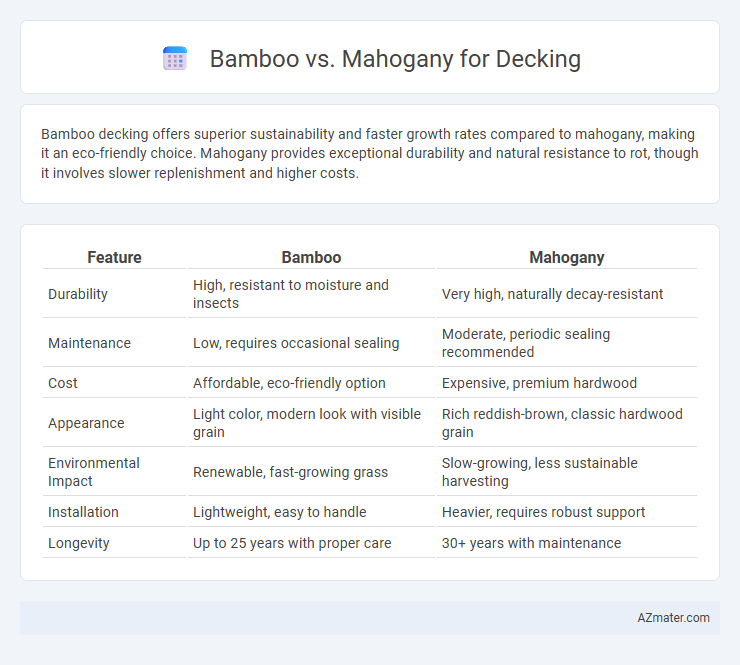Bamboo decking offers superior sustainability and faster growth rates compared to mahogany, making it an eco-friendly choice. Mahogany provides exceptional durability and natural resistance to rot, though it involves slower replenishment and higher costs.
Table of Comparison
| Feature | Bamboo | Mahogany |
|---|---|---|
| Durability | High, resistant to moisture and insects | Very high, naturally decay-resistant |
| Maintenance | Low, requires occasional sealing | Moderate, periodic sealing recommended |
| Cost | Affordable, eco-friendly option | Expensive, premium hardwood |
| Appearance | Light color, modern look with visible grain | Rich reddish-brown, classic hardwood grain |
| Environmental Impact | Renewable, fast-growing grass | Slow-growing, less sustainable harvesting |
| Installation | Lightweight, easy to handle | Heavier, requires robust support |
| Longevity | Up to 25 years with proper care | 30+ years with maintenance |
Introduction to Bamboo and Mahogany Decking
Bamboo decking offers a sustainable, fast-growing alternative known for its high strength-to-weight ratio and natural resistance to moisture and insects. Mahogany decking provides exceptional durability, rich color, and resistance to decay, making it a premium choice for long-lasting outdoor flooring. Both materials require proper sealing and maintenance to preserve their appearance and structural integrity in various weather conditions.
Origin and Sustainability of Materials
Bamboo originates primarily from Asia and is renowned for its rapid growth, reaching maturity in 3 to 5 years, making it a highly renewable resource ideal for sustainable decking. Mahogany, sourced mainly from tropical rainforests in Central and South America, grows slowly and faces challenges related to deforestation and illegal logging, impacting sustainability negatively. Bamboo's regenerative cultivation and lower environmental footprint contrast with mahogany's ecological concerns, positioning bamboo as the more eco-friendly option for decking materials.
Durability and Lifespan Comparison
Bamboo decking offers exceptional durability due to its high tensile strength and natural resistance to moisture, fungi, and insects, typically lasting 20 to 25 years with proper maintenance. Mahogany decking, known for its dense hardwood structure, provides excellent resistance to rot and decay, often enduring up to 40 years when well maintained. While mahogany generally surpasses bamboo in lifespan, bamboo's rapid renewability and sustainable harvesting make it a durable, eco-friendly alternative for decking projects.
Aesthetic Appeal: Color and Grain Differences
Bamboo decking showcases a light golden hue with a consistent, fine grain that offers a modern and sleek appearance, while mahogany presents a rich, deep reddish-brown color with a pronounced, swirling grain pattern that adds classic elegance and warmth. Bamboo's uniform texture provides a minimalist aesthetic ideal for contemporary outdoor spaces, contrasting with mahogany's natural variation and luxurious finish often favored in traditional or upscale designs. Both materials age differently, with bamboo typically maintaining brightness longer under UV exposure, whereas mahogany develops a deeper patina that enhances its character over time.
Maintenance Requirements for Each Option
Bamboo decking requires regular sealing and cleaning to prevent moisture damage and maintain its durability, typically needing resealing every 1-3 years depending on exposure. Mahogany decking demands less frequent maintenance, with periodic sealing and occasional sanding to preserve its natural oils and resist rot and insect damage. Both materials benefit from proper cleaning to avoid mold and mildew, but mahogany generally offers longer-lasting resilience with lower upkeep intensity.
Cost Analysis: Bamboo vs Mahogany
Bamboo decking generally costs $5 to $8 per square foot, offering an affordable and sustainable option compared to mahogany, which ranges from $15 to $25 per square foot due to its premium hardwood quality. Bamboo requires less maintenance and has a faster installation process, further reducing long-term expenses, while mahogany demands regular sealing and higher upkeep costs. Considering durability and environmental impact, bamboo provides a cost-effective choice without sacrificing strength, whereas mahogany's higher price reflects its luxurious appearance and natural resistance to decay.
Weather Resistance and Climate Suitability
Bamboo decking offers excellent weather resistance due to its natural silica content, making it highly resistant to moisture, rot, and insect damage, particularly in humid and tropical climates. Mahogany, while durable and naturally resistant to decay, performs best in moderate climates where extreme moisture and temperature fluctuations are less common. Bamboo's rapid growth and treatment options enhance its adaptability to various climates compared to mahogany's slower growth and preference for stable, temperate environments.
Eco-Friendliness and Environmental Impact
Bamboo decking is highly eco-friendly due to its rapid growth rate and sustainable harvesting practices, which minimize deforestation and soil erosion. Mahogany, although durable, is often associated with slower growth and concerns related to illegal logging and habitat destruction, making it less environmentally sustainable. Choosing bamboo supports renewable resource management and reduces carbon footprint compared to the higher environmental impact of mahogany production.
Installation Process and Ease
Bamboo decking offers a straightforward installation process due to its lightweight nature and consistent plank size, making it easier to handle and cut compared to mahogany. Mahogany decking requires more precision during installation because of its dense hardwood properties, which can demand specialized tools and expertise for accurate fitting. Both materials benefit from pre-drilling for fasteners to prevent splitting, but bamboo's uniformity often results in faster overall installation times and reduced labor costs.
Final Recommendations: Which Material is Best for Your Deck?
Bamboo offers a highly sustainable and eco-friendly choice for decking, featuring rapid growth and impressive durability, ideal for environmentally conscious homeowners seeking a lightweight option. Mahogany provides exceptional hardness, rich coloration, and natural resistance to decay, making it perfect for those prioritizing luxury aesthetics and long-term structural integrity. Selecting between bamboo and mahogany depends on budget, maintenance willingness, and design preferences, with bamboo excelling in sustainability and affordability, while mahogany stands out for premium quality and durability.

Infographic: Bamboo vs Mahogany for Decking
 azmater.com
azmater.com